To plant a garden is to believe in tomorrow. Never has a truer word been spoken for the extensive gardens at Wentworth Woodhouse.
But it is the selfless hard work of the team behind its upkeep that is cultivating a bright future for the people’s stately home.
The magnitude of the gardens and its multifarious design means the task at hand is no mean feat. Indeed, when Humphry Repton originally laid out the 50 acres of pleasure grounds in 1790, he deemed it his most prestigious project – that coming from a prominent name who had landscaped Clumber Park, Harewood House and Rudding Park. At its peak, there would have been 33 full-time gardeners employed by the Earls Fitzwilliam.
So, how gallant that the majority of today’s garden workforce are volunteers.
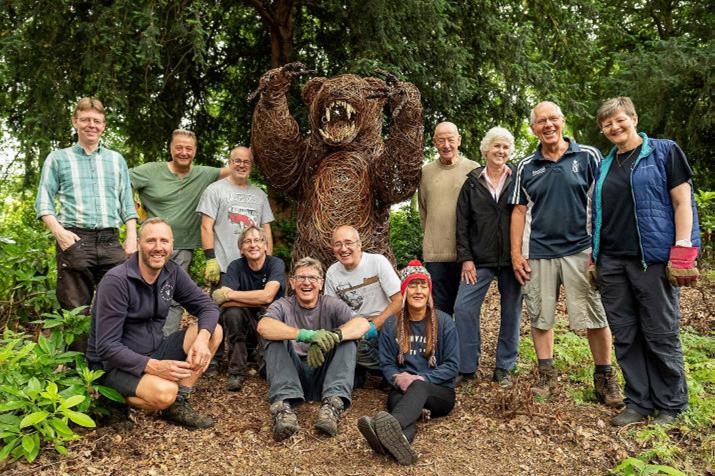
Under the leadership of head gardener Scott Jamieson and his deputy Andy Smith, there are two groups of volunteers – the Tuesday Welly Wangers and the Wednesday Bramble Bashers – who tend to the gardens week in week out. They are also supported by members of Artworks South Yorkshire, a creative organisation for adults with disabilities, who have an ongoing volunteer placement scheme for service-users to build workplace skills in the gardens.
Come rain or shine, this hardy bunch lace up their boots, grab a barrow and some tools, and head out into gardens for a full day’s graft.
“You couldn’t buy a ticket to do what we do,” says Martin Brook, a Welly Wanger. His thoughts are echoed by Bramble Basher Julie Meese who decided she’d never work for money again after retiring from Sheffield City Council. “It wouldn’t be the same if we got paid. None of us have to be here but we are all so proud of the legacy we’re creating.”
It was a glorious morning in early March when we met, the spring sun emphasising the natural beauty (and sheer size) of the landscape even before its abundance of flowers were in bloom. Considering just a few hours earlier driving into work I had the wipers on, hastily clearing the pelting rain from the windscreen naively thinking our outdoor meeting would be cancelled, we couldn’t have timed it better.
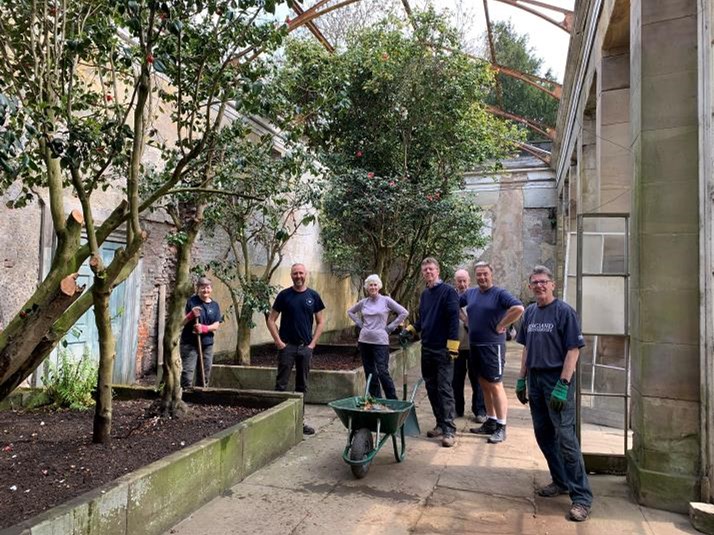
As Welly Wanger Sue Chadwick says: “It doesn’t matter what the weather is doing, we’ll still be here in force. We get a bit wet sometimes but who cares when this is the backdrop.”
If it does rain, the team now has a brand-new cabin to shelter in at lunch and tea breaks, bought for them personally as a thanks from chair of trustees, Dame Julie Kenny, after their old one had seen better days.
A growing team of volunteers
Thirteen volunteers were there on the day to tackle the last week of snowdrop jobs which had been delayed due to lockdown. Some volunteers are amateur or hobby gardeners, while others, like Sue who they dub the ‘Plant Lady’ due to her knowledge of species and Latin names, are mavens who have made strides within the local gardening scene.
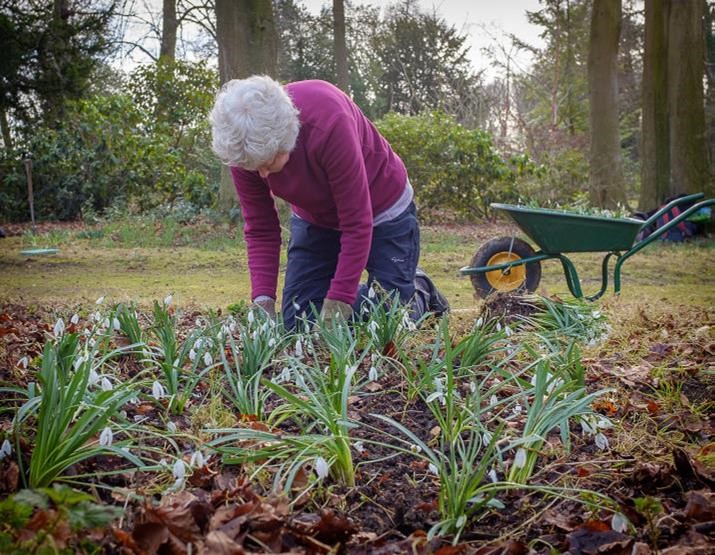
The volunteers are mainly retired and come from all different backgrounds and careers, from nurses to teachers and company directors. Most have been involved since Wentworth Woodhouse Preservation Trust did a social media call-out for volunteers when they took over the house in 2017.
Many members also combine their work in the garden with voluntary roles within the house, helping with admin, events, and documenting the grand restoration through photography and film. Ally Butler worked for the NHS for 30 years – 17 of those as a nurse at Sheffield Children’s Hospital – and retired three years ago. She now volunteers in the gardens, helps with weddings at the house, and does a day a week with the admin team.
“I had quite a senior position within the NHS so I think the staff in the offices think I shouldn’t be doing basic tasks like inputting data into spreadsheets. But I’m not pompous or proud. If what I do at Wentworth Woodhouse helps other people then that’s good for me,” she says.
Before last year, the only access the public had to the grand gardens was via pre-booked guided tours. However, last summer the Trust decided to fully open the gardens so that more people could benefit and appreciate what the house had to offer. And since then, the volunteers’ work outdoors has continued to grow.
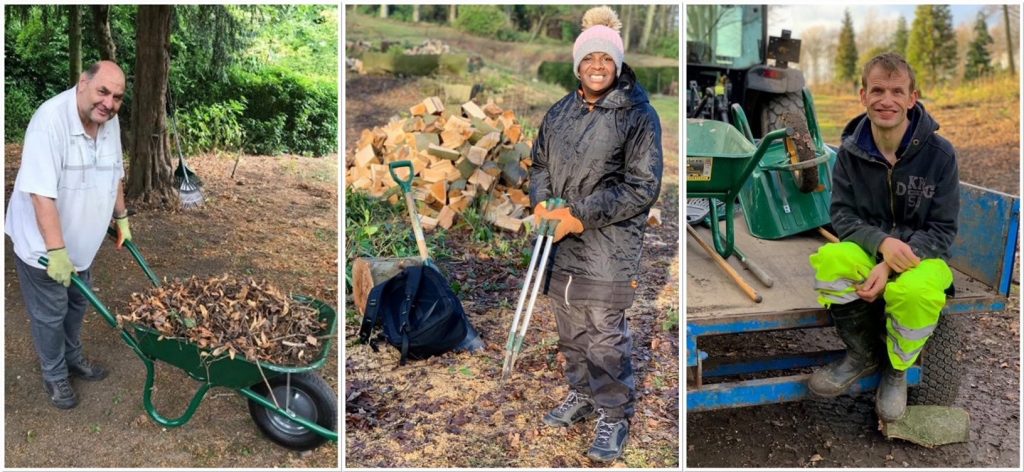
“We can’t manage without the volunteers. I don’t like to think of them as just free labour; they’re our garden team and have become ambassadors since the groups launched in 2017. They even saved their collective daily expenses up and match funded to buy some new benches for the gardens knowing it was something the Trust would have loved to do if the priority for funding wasn’t on urgent repair work to the house,” Scott says.
Nurtured by head gardener, Scott Jamieson
Scott has worked at Wentworth Woodhouse for over 16 years, the majority of that time tackling the mammoth maintenance programme by himself. He started his career taking care of golf courses in his native Scotland, before moving to Italy for eight years. Scott then ran a fashionable florist in Manchester which had a concession in Selfridges.
“When I moved to Rotherham, I made a throwaway comment that I’d love to work at a stately home. I’d never even heard of Wentworth Woodhouse but four months later I was employed by the Newbolds who owned the house at the time. The garden that the Trust now has is owed in part to the vision and investment the Newbolds had in the garden – and my backing of them.
“The little buds we planted back then that were yey-high have since gone on to become real talking points. When you’re busy it all seems to happen behind your back; you don’t realise the plants are rewarding you until you see them flower. Whoever takes on the garden after me will have the bones of a very good garden.”
A year-round task
Now the gardens are open to the public, most visitors who step through the charming archway from the Stable Block into the magical hidden landscape finally understand the scale of the workload.
“People think it’s just a case of deadheading but it’s brutal. We’re not called the Bramble Bashers for nothing,” says Julie. “We get scratched to bits but it’s very satisfying. If you have a stressful career, you don’t notice until you finish. Raking, digging, scraping – all those jobs we do here are liberating.”
The volunteers work year-round so that visitors can experience the gardens in all seasons.

Early in the year it’s a blank canvas before the snowdrops herald the excitement about to begin. This year, the gardens had around 5,000 visitors between January and March to see the spectacle of snowdrops. Daffodils and bluebells synonymous with springtime then make way for the spectacular appearance of rhododendrons with their long flowering season. When it gets going, the herbaceous border is brilliant, edged by a hill that cries out to be rolled down – the ultimate undulating fun.
One of Repton’s influences on the gardens was the number of trees he had planted, meaning the garden can be shaded in parts. But in autumn, how wonderful it is to see the last ebbs of greenery fade away, heralding the arrival of rich oranges and browns.
“The gardens are at their best in later summer when everything is in full bloom. But there is so much to see all year round, including lots of wildlife. We get stoats, bats and birds. There are a couple of owls too that you can never pinpoint until you hear a hoot,” Scott says.
Discovering the gardens
If you didn’t know the gardens at Wentworth Woodhouse existed, you wouldn’t be on your own. It wasn’t that long ago that ‘Keep Off!’ signs and a huge barrier of conifers obscured the view of the Stable Block. Many of the garden team didn’t know what was behind the magnificent façade of the house, including Sue who has lived in Wentworth for 35 years.
“I knew there was a garden here, but I’d never even seen it let alone been in it. I’d volunteered for the house for quite a while and didn’t realise they had a gardening team. I’ve been a gardener all my life, ever since being a child, so I jumped at the chance to join,” she says.
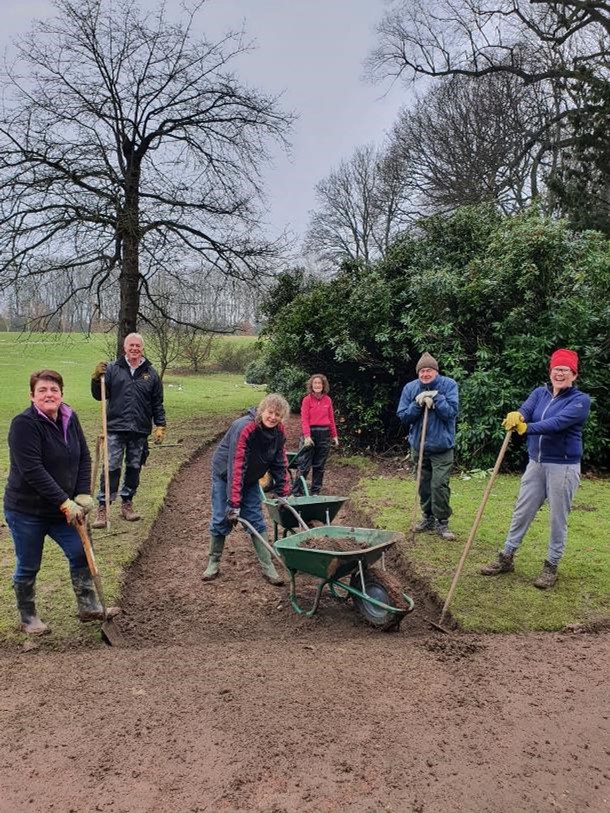
A lot of the volunteers have a local connection to the house, including Alan Williams who lives in Elsecar and remembers going to the swimming pool when it was open to the public. Martin Brook lived at nearby Nether Haugh House in the ‘70s and his childhood was spent swimming in the dams at Greasbrough and playing in the fields, always hiding from the estate gamekeeper. A Lady Mabel College student also stayed with his family during her time studying at Wentworth Woodhouse.
“I never got in Wentworth Woodhouse as a child, but I seem to have come full circle now I’m a volunteer. You couldn’t make it up,” Martin says.
Parts of the original kitchen and ornamental gardens are now within the boundary of the nearby garden centre. However, visitors to the eclectic gardens at Wentworth Woodhouse can see many of Repton’s original features and historic monuments, such as the 15ft tall Punchbowl urn from 1837, an Icehouse, or the 18th Century Ionic Temple that stands proudly on the 1,500ft long South Terrace with panoramic views over neighbouring villages.
“It’s a lovely office to work in,” says Mike Harrison, a retired bank manager who volunteered for the Trust before they’d even asked for extra helping hands. “I never thought I’d have had an office job, never mind spend all my working life in one. I love being outdoors and was a keen sportsman in my time so joining the gardens team was great for me. You can visually see where you’ve made a difference straight away and the effect you’ve had on the gardens. People who haven’t been just don’t get it ‘till they see this place.”
In a twist of fate, Mike’s wife Marion had family who lived in Wentworth and were gardeners for the 7th Earl, Billy. Her uncle Doug Mitchell, his brother and father all worked at Wentworth Woodhouse in the 1930s before the start of WWII.
“I used to help Doug on his allotment, I guess I was like his apprentice. He’d tell me stories about having to doff his cap when the Earl came by. It was quite formal then, all ‘yes m’lord and m’lady.’ I remember Doug telling me how he was working in the greenhouse when Billy came in and asked him to clip a rose for her ladyship,” Mike says.
A habitat for change
Historic features sit side by side heterogenous new additions aimed at rekindling the imagination of families used to tech-heavy environments. While there might not be a swing or a climbing frame for kids, the whole garden is nature’s playground. There is a mud kitchen for unlimited messy play, a piano on the lawn for spontaneous singsongs, and a grizzly bear made of sticks hiding in the forest of bewilderment. Traditional summer games are played on the lawn such as croquet and hula hoops, and this year a new barefoot sensory garden has been created.

Another new addition to the gardens this summer will be the wooden summerhouses that can be hired out for exclusive use. The two cabins sit somewhat organically in parts of the gardens ravaged by open-cast mining creating an amphitheatre feel. But Scott says he feels they have been gifted a new purpose amongst the devastating loss of planting in those areas. The new cabins will help nurture the future of the House and gardens by offering a shelter for families, a venue for children’s parties, or somewhere families can gather for a special celebratory afternoon tea.
Retired teacher Alan Williams knows how important it is to modernise the offer to appeal to a new generation of visitors. “We’ve got to keep going forward. There is no point just saying there is a garden here and that’s that. We get real joy from seeing people walking around enjoying the fruits of our labour. It’s not unusual for people to arrive at 9.30am and still be here when we’re closing the gates, people who want to stop and talk to us with sincere intrigue. Listening to children laughing is just magical.”
One of the recent projects the garden team has undertaken to improve accessibility is the revival of the garden’s 200-year-old formal paths. Scott researched the original routes including the old carriage drive that had completely grassed over. The volunteers helped shovel and rake 58 tonnes of Scottish red granite gravel on the newly dug paths to mimic the original red shale that would have been used from the Earl’s collieries.

As we meandered through the gardens on our visit, the extent of the paths in both width and length really hit home how backbreaking this project must have been.
“The wide paths are great for social distancing, but just you imagine what the ladies in the 18th century would have been wearing as they took a leisurely stroll outdoors. It certainly wouldn’t have been skinny jeans, that’s for sure,” Alan jokingly gestures at my own outfit of choice. A lady’s hooped skirt with layers of petticoats would easily pass through the gardens without so much as a snag on a nearby branch.
Future projects
As things continue to blossom, Scott is keen to ensure the garden remains as sustainable as possible with little to no impact on the environment. The volunteers already grow and sell their own flowers – things that people wouldn’t grow themselves or are reminiscent of the past – but there are plans to create a self-sustaining flower farm.
One of the larger projects on the horizon is the redevelopment of the grade II listed Camellia House to the rear of the gardens. The plan is to transform the derelict building back to its original use from 1738 as an orangery that was used as a tearoom by Lady Rockingham, the wife of the 1st Marquess. A daytime tearoom will couple up with an evening events space.
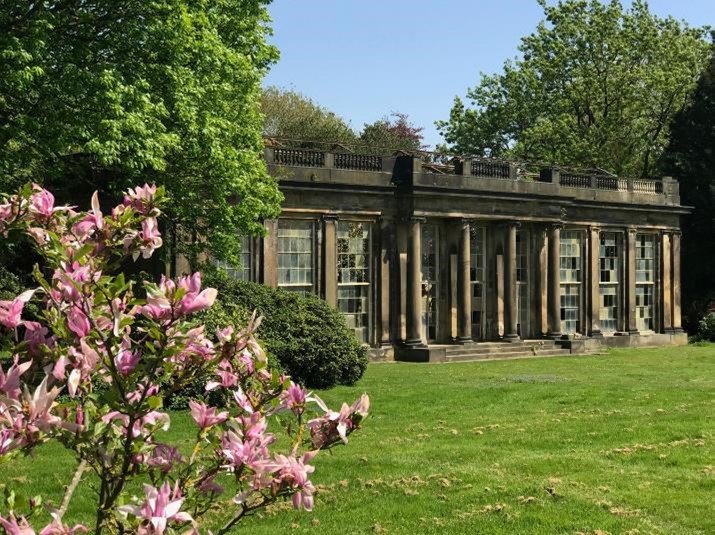
The painstaking multi-million-pound project will see the historic building carefully restored, protecting the collection of Camellias which are some of the oldest and rarest in the western world. The 2nd Marquess was one of the earliest collectors of rare blooms from China and Japan, so it is uncanny that today’s head gardener Scott’s Manchester florist was one of the first importers of exotic blooms used in bouquets presented to superstars like Madonna and Beyonce.
Daring projects such as the Camellia House will help safeguard the fate of Wentworth Woodhouse in years to come. But for now, we can all enjoy this historic habitat right on our doorsteps for a purse-friendly day out for all the family.
General admission to the garden when pre-booked online is £6 for adults and £3 for children aged five to 16. Or a family ticket for two adults and two children is £12. The gardens are open Wednesday to Sunday 10am-4pm. www.wentworthwoodhouse.org.uk






